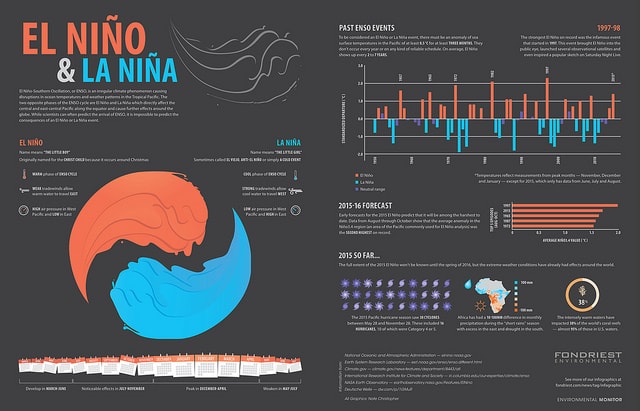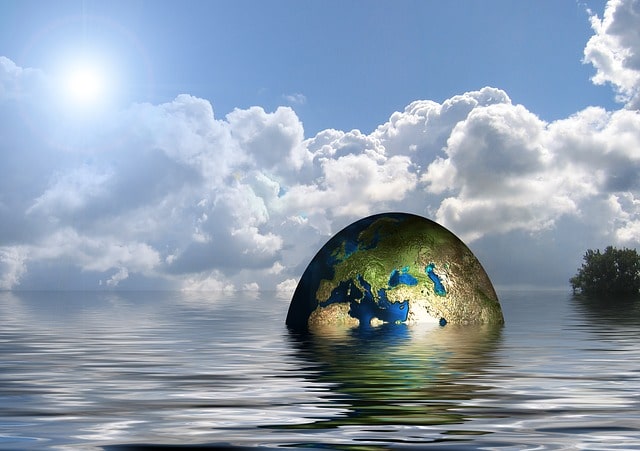What is La Niña and Causes and Effects of La Niña

La Niña is a natural event characterized by abnormal cold ocean temperatures in the Equatorial Pacific. It is actually the opposite of El Niño which is normally realized when the Equatorial Pacific experiences unusual warm ocean temperatures. According to the Australian Bureau of meteorology, La Niña is the positive stage of the El Niño Southern Oscillation (ENSO) which is sometimes called the “opposite of El Niño”.
La Niña is thus defined as the intense cooling of the eastern and central tropical Pacific Ocean, frequently experienced together with warmer than normal sea surface temperatures in the west side of the Pacific. Just like an El Niño event, La Niña is tied to increased chances of extensive changes in global weather.
NOAA define La Niña as,
“La Niña is characterized by unusually cold ocean temperatures in the Equatorial Pacific, compared to El Niño, which is characterized by unusually warm ocean temperatures in the Equatorial Pacific. The graphic below shows the sea surface temperature in the equatorial Pacific (20ºN-20ºS, 100ºE-60ºW) from Indonesia on the left to central America on the right.”
A number of tropical cyclones, drought, and wetter conditions are correlated with La Niña events. In precise, El Niño and La Niña are the opposite features of the El Niño Southern Oscillation (ENSO) cycle.
According to Wikipedia,
“La Niña is a coupled ocean-atmosphere phenomenon that is the counterpart of El Niño as part of the broader El Niño–Southern Oscillation climate pattern. The name La Niña originates from Spanish, meaning “the girl”, analogous to El Niño meaning “the boy”. It has also in the past been called anti-El Niño, and El Viejo. During a period of La Niña, the sea surface temperature across the equatorial Eastern Central Pacific Ocean will be lower than normal by 3–5 °C. “
Primary Causes of La Niña
La Niña is caused by the strengthening of the normal steady winds blowing from east to west above and below the equator (trade winds) that usually takes place after an El Niño event. Since during an El Niño the trade winds are weakened, the aftermath is the reinforcement of the winds which reverses the El Niño wind cycle which strengthens non-El Niño wind cycle.
As an outcome, the winds pushes the warmest waters in the equatorial Pacific further to the western side than normal thereby increasing the pulling up of cold water to the surface towards the eastern direction. Essentially, La Niña is caused by the strengthening of the trade winds with results in pushing of cold surface water to the east and less cold water to the west.
The resultant displacement of atmospheric and global wind cycle circulation contributes to extensive changes in temperatures and weather around the world. La Niña’s effects on global weather include droughts in the eastern equatorial Pacific and floods in the western equatorial Pacific.
Serious Effects of La Niña
-
Drought and dry conditions
El Niña is the opposite of El Niño; hence, it presents drought and dry conditions in the eastern side of the equatorial Pacific as opposed to the western side. The dry spells and droughts are mostly witnessed in the coastal regions of Peru and Chile which may result in poor crop yields. These conditions are experienced because the normal wind cycles that fetch rain are reversed due to the shift of the global wind cycle circulation in the equatorial pacific.
-
Flooding and Heavy Rains
The changes brought about by La Niña conditions after El Niño may as well prevail for many months and with the ocean temperatures becoming cooler towards the east, the ensuing rainy weather patterns in the oceans bring about heavy rains and floods that may last for extended periods.
Just like the El Niño, the heavy rains and floods are experienced far beyond the ocean shores in the main land, destroying property and rendering people homeless for months. La Niña is associated with the higher than normal rainfall in the central Andes (South America), often causing catastrophic flooding. Very heavy rains and flooding in the Philippines, Brazil, Malaysia, and Indonesia are also largely determined by the La Niña.
-
Occurrence of Typhoons, Hurricanes and very cold weather
The strengthening of trade winds in La Niña events is associated with some of the incidences of serious typhoons, hurricanes and very cold weather in various parts of the world. In Asia, the formation of severe tropical cyclones which heightens the landfall threat to China is correlated with the westward shifts across the western Pacific Ocean brought about by the La Niña.
La Niña also allows for the development of stronger than normal hurricanes in the Atlantic and equatorial Pacific areas. In Canada, La Niña is tied to the cooler and snowier winter such as the very harsh snowy winter of 2007/2008 registered in Eastern Canada.






